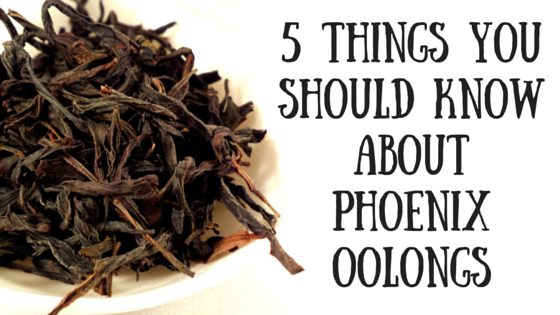Phoenix oolongs are one of my favorite kinds of tea but I feel like there isn’t nearly as much information out there about them. When I tried my first Huang Zhi Xiang from Seven Cups Fine Chinese Teas many years ago I knew that there was no going back. They have a reputation for being temperamental but patient tea drinkers are rewarded with intoxicating fragrances and seemingly limitless infusions. I’m planning to post some more thorough information in the future but to get you guys started, here’s a quick list of five things every tea drinker should know.
The Chinese term for Phoenix oolongs is Dan Cong.
Although to an English speaker it looks like it would be pronounced dan-kong, it’s actually more like dan-song. The literal translation is single bush or trunk. While some interpret this as meaning that each batch of tea is made from a single plant, we also have to consider the economic feasibility of that kind of exclusivity. Commercially available Dan Cong is more likely to be harvested from clones of the same tree that are planted together.
The long, twisty leaves are what is known as a strip-style oolong.
When we think of oolong, we usually picture the tightly rolled balls of Tie Guan Yin or Dong Ding but oolong is a broad and diverse category of tea. The shape is produced through a rolling step that breaks down the cell walls of the leaves. Traditionally this was done by hand but is more commonly done by machine now. Medium oxidization and charcoal roasting are the traditional processing methods but there’s a lot more experimentation these days.
They can only be produced in the Guang Dong Province of China.
Guang Dong is located on the southern coast of China. Phoenix oolongs are named after the mountain region where they are grown, Feng Huang Shan, in Chaozhou. The combination of volcanic soil and large temperature changes throughout the day creates a tea that is unique to this region. Tea always seems to taste better when it has to work harder to grow. 🙂
They’re the doppelganger of the tea world.
Phoenix oolongs are famous for their exotic fragrances that mimic everything from flowers and fruit to nuts. The most common is probably Mi Lan Xiang, aka honey orchid fragrance, but there are hundreds of different fragrances. Ju Duo Zai is a hard to find favorite of mine that is reminiscent of almonds. Most of these teas are named after what they smell or taste like with the possible exception of the dubiously named Ya Shi Xiang. The literal translation is “duck shit fragrance” but it most assuredly does not taste like that (as far as my experience goes anyway).
Short, hot steeps are best.
Dan Cong oolongs can be a bit temperamental when it comes to brewing. Very hot water is required to extract the full flavor but it can also lead to bitterness. Although they can be brewed in a western fashion I very much prefer gongfu methods because it provides more control. After a very short rinse, I’ll usually use boiling water and 30-second infusions. The leaf volume depends on the tea and your brewing vessel. If the leaves are more broken (like the ones you’ll find at the bottom of a bag) they are more likely to be bitter so I’d recommending cutting back a bit.
There’s an astonishing lack of information on this type of tea available for tea lovers here in the states. One resource that I often find myself turning to is A Tea Lover’s Travel Diary by Jason C.S. Chen. Writing this post made me realize that I completely spaced on posting a review of that book here. I promise to get right on that!
Is there something that you think should be on this list? Let me know in the comments!
